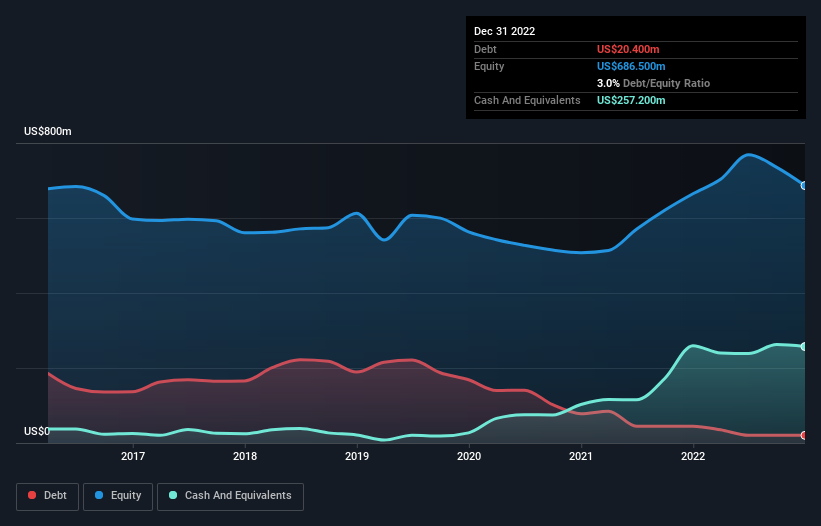Warren Buffett famously said, 'Volatility is far from synonymous with risk.' So it seems the smart money knows that debt - which is usually involved in bankruptcies - is a very important factor, when you assess how risky a company is. We note that TimkenSteel Corporation (NYSE:TMST) does have debt on its balance sheet. But the real question is whether this debt is making the company risky.
When Is Debt A Problem?
Debt is a tool to help businesses grow, but if a business is incapable of paying off its lenders, then it exists at their mercy. If things get really bad, the lenders can take control of the business. However, a more common (but still painful) scenario is that it has to raise new equity capital at a low price, thus permanently diluting shareholders. Of course, debt can be an important tool in businesses, particularly capital heavy businesses. The first thing to do when considering how much debt a business uses is to look at its cash and debt together.
See our latest analysis for TimkenSteel
What Is TimkenSteel's Net Debt?
The image below, which you can click on for greater detail, shows that TimkenSteel had debt of US$20.4m at the end of December 2022, a reduction from US$44.9m over a year. But it also has US$257.2m in cash to offset that, meaning it has US$236.8m net cash.

A Look At TimkenSteel's Liabilities
According to the last reported balance sheet, TimkenSteel had liabilities of US$186.7m due within 12 months, and liabilities of US$208.8m due beyond 12 months. Offsetting this, it had US$257.2m in cash and US$79.4m in receivables that were due within 12 months. So its liabilities total US$58.9m more than the combination of its cash and short-term receivables.
Of course, TimkenSteel has a market capitalization of US$753.7m, so these liabilities are probably manageable. Having said that, it's clear that we should continue to monitor its balance sheet, lest it change for the worse. While it does have liabilities worth noting, TimkenSteel also has more cash than debt, so we're pretty confident it can manage its debt safely.
The modesty of its debt load may become crucial for TimkenSteel if management cannot prevent a repeat of the 46% cut to EBIT over the last year. Falling earnings (if the trend continues) could eventually make even modest debt quite risky. When analysing debt levels, the balance sheet is the obvious place to start. But it is future earnings, more than anything, that will determine TimkenSteel's ability to maintain a healthy balance sheet going forward. So if you're focused on the future you can check out this free report showing analyst profit forecasts.
Finally, a company can only pay off debt with cold hard cash, not accounting profits. While TimkenSteel has net cash on its balance sheet, it's still worth taking a look at its ability to convert earnings before interest and tax (EBIT) to free cash flow, to help us understand how quickly it is building (or eroding) that cash balance. Over the last two years, TimkenSteel recorded free cash flow worth a fulsome 95% of its EBIT, which is stronger than we'd usually expect. That positions it well to pay down debt if desirable to do so.
Summing Up
We could understand if investors are concerned about TimkenSteel's liabilities, but we can be reassured by the fact it has has net cash of US$236.8m. The cherry on top was that in converted 95% of that EBIT to free cash flow, bringing in US$107m. So we don't have any problem with TimkenSteel's use of debt. The balance sheet is clearly the area to focus on when you are analysing debt. But ultimately, every company can contain risks that exist outside of the balance sheet. For example TimkenSteel has 2 warning signs (and 1 which doesn't sit too well with us) we think you should know about.
Of course, if you're the type of investor who prefers buying stocks without the burden of debt, then don't hesitate to discover our exclusive list of net cash growth stocks, today.
New: Manage All Your Stock Portfolios in One Place
We've created the ultimate portfolio companion for stock investors, and it's free.
• Connect an unlimited number of Portfolios and see your total in one currency
• Be alerted to new Warning Signs or Risks via email or mobile
• Track the Fair Value of your stocks
Have feedback on this article? Concerned about the content? Get in touch with us directly. Alternatively, email editorial-team (at) simplywallst.com.
This article by Simply Wall St is general in nature. We provide commentary based on historical data and analyst forecasts only using an unbiased methodology and our articles are not intended to be financial advice. It does not constitute a recommendation to buy or sell any stock, and does not take account of your objectives, or your financial situation. We aim to bring you long-term focused analysis driven by fundamental data. Note that our analysis may not factor in the latest price-sensitive company announcements or qualitative material. Simply Wall St has no position in any stocks mentioned.
About NYSE:MTUS
Metallus
Manufactures and sells alloy steel, and carbon and micro-alloy steel products in the United States and internationally.
Good value with reasonable growth potential.
Similar Companies
Market Insights
Community Narratives



